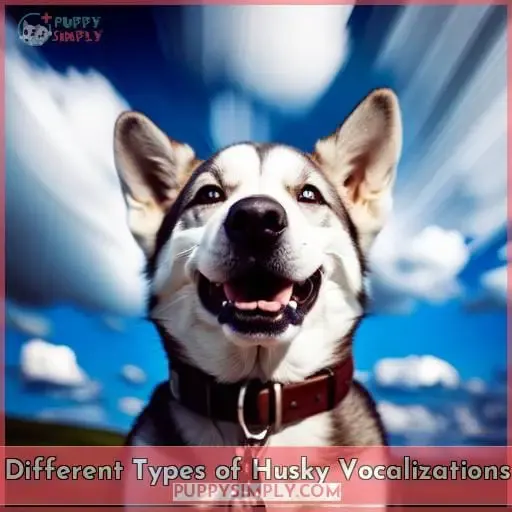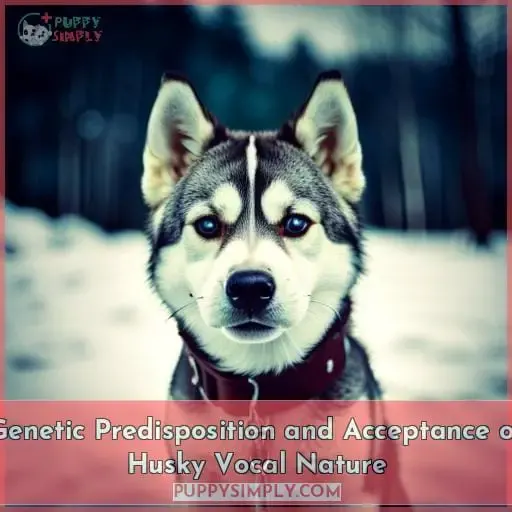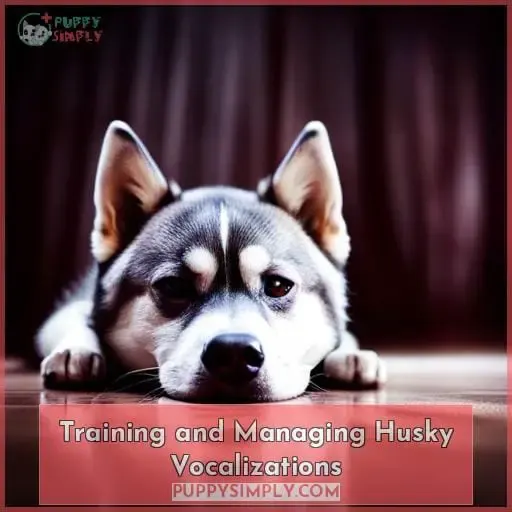This site is supported by our readers. We may earn a commission, at no cost to you, if you purchase through links.
 Imagine being able to truly understand why your Husky cries. In this article, we will delve into the vocal nature of this beloved breed and uncover the reasons behind their expressive sounds. From howling to barking, these canine companions have a unique way of communicating with us.
Imagine being able to truly understand why your Husky cries. In this article, we will delve into the vocal nature of this beloved breed and uncover the reasons behind their expressive sounds. From howling to barking, these canine companions have a unique way of communicating with us.
By exploring their genetic predisposition and learning effective management techniques, you’ll gain valuable insights that can help create a harmonious bond with your crying Husky.
Table Of Contents
Key Takeaways
- Huskies cry to communicate various emotions such as loneliness, boredom, frustration, pain, and fear.
- Vocalizations are important for huskies to express emotions, communicate with their pack members, and strengthen social bonds.
- Different types of husky vocalizations include howling, excitement barking, and groaning.
- Huskies have a genetic predisposition for being a loud breed, so it is important to understand and manage their vocal tendencies.
Why Do Huskies Cry?
When it comes to understanding why huskies cry, it’s important to recognize that their vocalizations serve as a form of communication and emotional expression.
Through their diverse range of sounds like screams, howls, whines, and cries, huskies convey various emotions such as frustration, excitement,and anxiety.
By interpreting the context and recognizing the distinct meanings behind each sound in their communication repertoire , you can gain insight into what your husky may be trying to express.
Communication Through Vocalization
When you’re listening to your husky’s cries, recognize that they’re communicating various emotions through their vocalizations.
As you spend more time understanding the nuances of your husky’s vocal expressions, you’ll better interpret cues signaling:
- Joy or excitement
- Anxiety due to separation
- Boredom or frustration.
Learning these emotional patterns enables clearer communication.
Emotional Expression
Have you ever wondered why huskies cry?
Huskies use their vocalizations to express a wide range of emotions and communicate with their owners.
Their cries serve as emotional signals, indicating feelings of joy, excitement, frustration, or anxiety.
Understanding the reasons behind their cries is essential for managing anxiety and promoting interactive bonding.
Additionally, paying attention to changes in vocal patterns can also serve as health indicators for these expressive dogs.
Vocal training plays a crucial role in effectively communicating and addressing the emotional needs of huskies.
The Importance of Vocalization for Huskies
Understanding the vocalization patterns and behaviors of huskies is crucial for appreciating their breed characteristics. Huskies rely on vocalizations to communicate with their pack members, express emotions, and strengthen bonds.
By recognizing the importance of vocalization in husky communication, you can better understand and respond to your furry companion’s needs.
Pack Mentality and Communication
To understand why huskies cry, it’s important to recognize the significance of vocalization in their pack mentality and communication.
- Vocal Training: Huskies can be trained to use specific vocal cues like ‘speak’ and ‘quiet’.
- Pack Dynamics: Vocalizations play a crucial role in maintaining social cohesion within the pack.
- Communication Signals: Howling and other tonal patterns serve as communication signals among huskies.
- Emotional Howling: Huskies may howl when expressing emotions such as excitement, anxiety, or loneliness.
Understanding these aspects of their nature helps decipher the reasons behind their crying behavior and fosters a deeper understanding of this unique breed’s social behavior dynamics.
Affection and Bonding
Stemming from their history as sled dogs working in packs, you’ll find Huskies talking to you as a natural behavior expressing affection and strengthening your bond. Their vocalizations are a form of communication and companionship that fosters a deep emotional connection.
Different Types of Husky Vocalizations
Huskies are known for their unique vocalizations, which include:
- Howling and calling the pack
- Excitement barking
- Groaning
Howling is a way for huskies to communicate with their pack or express excitement before activities like sled races. On the other hand, excitement barking and groaning serve as expressions of joy or contentment.
Understanding these different types of vocalizations helps decipher the emotions and intentions behind a husky’s cries.
Howling and Calling the Pack
In addition to communicating with their pack, Huskies also use vocalizations to call for you when they’re feeling lonely.
This is a natural behavior that stems from their pack mentality and strong connection to humans.
While it can be frustrating at times, it’s important to remember that this is how Huskies show their love and affection.
Excitement Barking and Groaning
After howling to call the pack, you may also hear your Husky bark with excitement or groan when they feel particularly good. This is normal, healthy, and natural expression of contentment. It isn’t a behavior issue and shouldn’t be discouraged.
Genetic Predisposition and Acceptance of Husky Vocal Nature
Huskies have a genetic predisposition for being a loud breed.
This means that they’re more likely to bark and howl than other breeds.
It’s important to be aware of this before bringing a Husky home, as you’ll need to accept and embrace their vocal nature.
Understanding the Breed’s Vocal Tendencies
Understanding your Husky’s vocal nature is crucial for a positive experience with this breed.
Their varied vocalizations, expressive nature, and emotional expressions are all part of their unique charm.
Accepting and Embracing the Vocal Nature
Understanding the breed’s vocal tendencies is crucial for choosing a Husky, as they’ve a genetic predisposition for being a loud breed.
Their vocalizations are a natural behavior and a form of communication and affection.
Training and Managing Husky Vocalizations
When training your Husky, it’s important to address over-excitement and frustration cues.
Signs of over-excitement include:
- Excessive barking
- Jumping
Frustration can be indicated by:
- Whining
- Growling
By recognizing and addressing these cues, you can help your Husky learn and behave in a positive way.
Addressing Over-Excitement During Training
To address over-excitement during training and effectively manage husky vocalizations, you can implement specific techniques.
Ensuring a calm state of mind is crucial for successful training sessions. Excitement can hinder the learning state, so it’s important to recognize signs of over-excitement and find solutions to address them.
Additionally, barking during training may indicate frustration, so identifying frustration cues and addressing them fosters positive training experiences in a calm learning environment that promotes success.
Recognizing Frustration Cues and Finding Solutions
Recognizing frustration cues in your husky and finding solutions is key to effectively managing their vocalizations during training.
Destructive behaviors, such as excessive barking or howling, can be triggered by factors like separation anxiety or a lack of mental stimulation.
Calming techniques and positive reinforcement are essential tools for addressing these issues and redirecting their energy towards more appropriate behavior.
By understanding the triggers behind their vocalizations, you can create a harmonious environment for both you and your furry friend.
Tips for Quieting a Crying Husky
To quiet a crying husky, it’s essential to create a calm environment and use positive reinforcement techniques.
Huskies often cry due to various reasons such as anxiety, boredom, or the need for attention. By providing a peaceful setting and rewarding desired behaviors with treats or praise, you can help alleviate their distress and reduce excessive vocalization.
Creating a Calm Environment
Creating a calm environment is key to quieting a crying husky. This includes:
- Providing quiet activities
- Calming music
- Dim lights
- Soothing sounds
- Limited distractions
- A comfortable space
- Alone time
- Chew toys
- Positive reinforcement with treats
Positive Reinforcement Techniques
Positive reinforcement techniques can help you teach your Husky to quiet down when they’re crying.
- Use treats, praise, and games to reward quiet behavior.
- Be consistent and patient with your training.
- Take time to build a bond with your Husky.
- Consider desensitization and counter-conditioning training if your Husky has separation anxiety.
Frequently Asked Questions (FAQs)
Why do huskies scream when they play?
Your husky screams when they play because they’re excited and having fun. Their screams are a way of expressing their joy and energy.
Why do huskies scream when they are excited?
Curious why huskies scream when they’re excited? Their expressive nature encompasses a variety of sounds like screams, indicating emotions like excitement and anxiety.
Why do huskies scream when they are scared?
Huskies scream when they’re scared as a way to communicate their fear and anxiety to you.
They may also howl or bark.
Why do huskies scream when they are alone?
When Huskies are alone, they may scream due to separation anxiety. This is a natural response to being separated from their pack, and it can be exacerbated by changes in routine or lack of social interaction.
Why do huskies scream when they are in pain?
Huskies scream when they’re in pain to communicate their discomfort and to seek help.
If you notice your husky screaming, it’s important to take them to the vet to rule out any medical issues.
Conclusion
Now that you have a better understanding of why your Husky cries, you can start to decode their vocalizations and respond accordingly. By understanding the different types of Husky vocalizations and their meanings, you can create a more harmonious bond with your furry friend.











